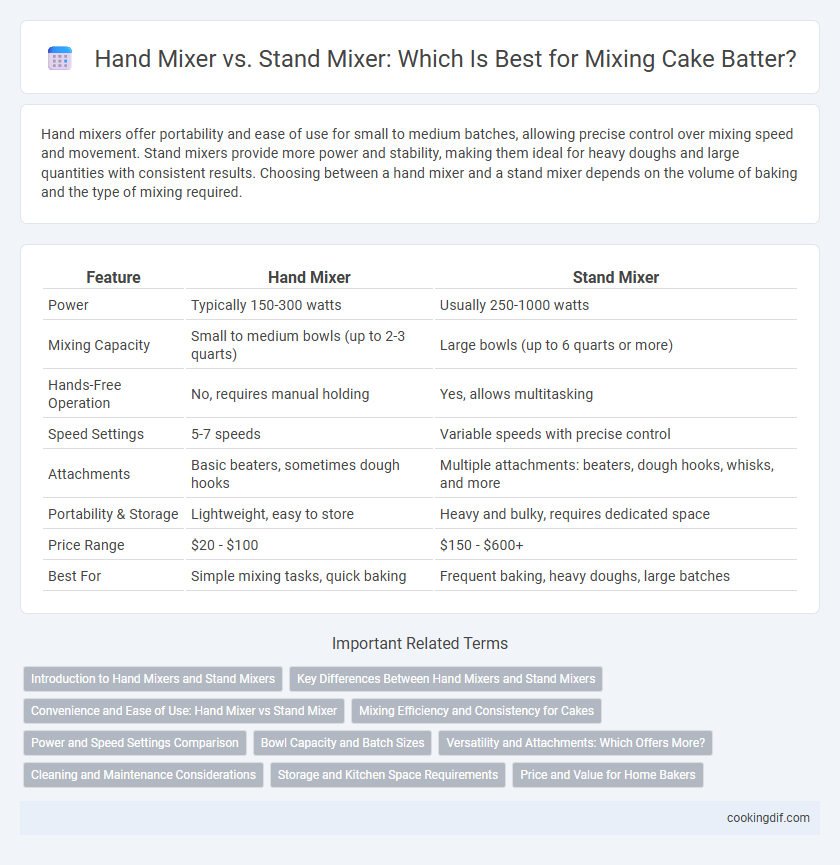Hand mixers offer portability and ease of use for small to medium batches, allowing precise control over mixing speed and movement. Stand mixers provide more power and stability, making them ideal for heavy doughs and large quantities with consistent results. Choosing between a hand mixer and a stand mixer depends on the volume of baking and the type of mixing required.
Table of Comparison
| Feature | Hand Mixer | Stand Mixer |
|---|---|---|
| Power | Typically 150-300 watts | Usually 250-1000 watts |
| Mixing Capacity | Small to medium bowls (up to 2-3 quarts) | Large bowls (up to 6 quarts or more) |
| Hands-Free Operation | No, requires manual holding | Yes, allows multitasking |
| Speed Settings | 5-7 speeds | Variable speeds with precise control |
| Attachments | Basic beaters, sometimes dough hooks | Multiple attachments: beaters, dough hooks, whisks, and more |
| Portability & Storage | Lightweight, easy to store | Heavy and bulky, requires dedicated space |
| Price Range | $20 - $100 | $150 - $600+ |
| Best For | Simple mixing tasks, quick baking | Frequent baking, heavy doughs, large batches |
Introduction to Hand Mixers and Stand Mixers
Hand mixers are lightweight, portable appliances with detachable beaters ideal for quick mixing tasks and small batches. Stand mixers offer powerful motors and multiple attachments, allowing hands-free operation and greater versatility for heavy doughs and complex recipes. Choosing between a hand mixer and a stand mixer depends on the frequency of baking, volume of mixing, and desired convenience in the kitchen.
Key Differences Between Hand Mixers and Stand Mixers
Hand mixers are lightweight, portable appliances ideal for small to medium mixing tasks and quick preparation, offering easy maneuverability and straightforward control. Stand mixers feature a powerful motor, multiple attachments, and a stationary design, making them suitable for heavy-duty mixing, dough kneading, and large-batch baking. The key differences lie in motor power, versatility, and capacity, where stand mixers outperform hand mixers in handling dense ingredients and prolonged use.
Convenience and Ease of Use: Hand Mixer vs Stand Mixer
Hand mixers offer lightweight portability and simple controls, making them convenient for quick tasks and small batches of cake batter. Stand mixers provide powerful motors and hands-free operation, allowing users to multitask while ensuring consistent mixing results for larger or more complex recipes. Choosing between the two depends on the frequency of baking, kitchen space, and the volume of ingredients typically prepared.
Mixing Efficiency and Consistency for Cakes
Hand mixers offer precise control for small to medium cake batters, providing consistent mixing with less volume but may struggle with dense or large batches. Stand mixers deliver superior mixing efficiency for large quantities and thick doughs, ensuring uniform batter texture through powerful motors and various attachment options. For optimal cake consistency, stand mixers maintain steady speed and thorough ingredient incorporation, reducing the risk of uneven crumb structures.
Power and Speed Settings Comparison
Hand mixers typically offer power outputs ranging from 100 to 300 watts with 5 to 7 speed settings, suitable for light to moderate mixing tasks like whipping cream or beating eggs. Stand mixers generally provide more robust power, often between 300 and 1000 watts, with variable speeds that allow precise control for heavy-duty mixing, kneading dough, and handling thick batters. The higher wattage and greater speed versatility of stand mixers make them more efficient and consistent for complex cake recipes requiring thorough mixing and aeration.
Bowl Capacity and Batch Sizes
Hand mixers typically have smaller bowl capacities, making them ideal for mixing small to medium batch sizes, such as one to two dozen cupcakes or a single-layer cake. Stand mixers offer larger bowl capacities, often ranging from 4.5 to 7 quarts, which accommodate bigger batch sizes and thicker doughs for multi-layer cakes or large batches of cookies. Choosing between the two depends on the volume of batter or dough, with stand mixers providing more efficiency and consistency when preparing larger quantities.
Versatility and Attachments: Which Offers More?
Stand mixers offer greater versatility with a wide range of attachments such as dough hooks, whisk attachments, and pasta rollers, allowing for diverse culinary tasks beyond basic mixing. Hand mixers typically come with fewer attachments, focusing mainly on beaters and sometimes a whisk, making them less adaptable for complex recipes. For bakers seeking multifunctional equipment, stand mixers provide a more comprehensive toolset that enhances cooking efficiency and creativity.
Cleaning and Maintenance Considerations
Hand mixers typically require less maintenance due to their simpler design and detachable beaters that are dishwasher safe, making cleaning quick and easy. Stand mixers, with their larger motors and attachments, demand more thorough cleaning, especially around the mixing bowl and attachment hubs, to prevent buildup and ensure longevity. Choosing a hand mixer minimizes daily cleanup, while a stand mixer's robust construction benefits from routine maintenance for optimal performance.
Storage and Kitchen Space Requirements
Hand mixers offer a compact design that requires minimal storage space, making them ideal for small kitchens or limited countertop areas. Stand mixers, while bulkier and demanding more dedicated kitchen space, provide enhanced stability and power for mixing heavy batters or large quantities. Selecting between the two depends largely on kitchen size constraints and the frequency or scale of baking tasks.
Price and Value for Home Bakers
Hand mixers typically range from $20 to $100, offering affordability and portability ideal for basic mixing tasks like whipping cream or beating eggs. Stand mixers, priced between $150 and $500, provide superior power and versatility with multiple attachments, making them a valuable long-term investment for serious home bakers who frequently mix dough or batter. Choosing between hand and stand mixers depends on balancing initial cost against the mixer's durability, power, and multifunctional capabilities crucial for diverse cake recipes.
Hand mixer vs Stand mixer for mixing Infographic

 cookingdif.com
cookingdif.com